2023 Fitness Industry Compensation Trends Report
IDEA and ACSM joined forces to present data on current wages and trends in the fitness industry.

It has been seven years since we last published the “Fitness Industry Compensation Trends Report,” and a lot has happened since that time. In 2020, our industry suffered crippling losses of revenue ($29.2 billion), and an estimated 22% of U.S. health clubs and studios were forced to permanently close due to COVID-19 lockdowns and restrictions (GHFA IRSHA & Deloitte 2022). The pandemic also caused 1.5 million fitness professionals to lose their jobs, which accounted for 47% of our fitness labor force.
The good news is that since COVID-19 restrictions have been lifted, our industry has resumed services, and we are seeing a healthy rebound in our memberships and workforce. Marketing research firms such as Jeffries and Statista suggest that gym memberships, as well as the number of employees, have steadily risen from 2020 to 2022 (Konik Barbero & MacMillan 2021; Gough 2022).
While most economists agree that the U.S. is currently not in a recession, it is suggested that one may be coming later this year. However, on the job front, our national unemployment rate for the past year has remained steady at about 3.5% (U. S. Bureau of Labor Statistics 2023a). And employment of fitness trainers and instructors is projected to grow 19% from 2021 to 2031, much faster than the average for all occupations (U.S. Bureau of Labor Statistics 2022).
In addition to encouraging job projections, this survey demonstrates that pay rates for all non-supervisory positions surveyed, except group exercise instructors and fitness floor staff, are above the national average ($33.18, May 2023; U. S. Bureau of Labor Statistics 2023b). All of our positions surveyed, management and nonsupervisory, have seen increases in wages since 2015. Unfortunately, not all of our positions’ wages have kept up with the rate of inflation. Adjusted for inflation, stable or lower numbers should be considered losses in traction for these positions.
This compensation trends report provides data on current wages in the industry as well as information on benefits and hiring and promotion criteria. We greatly expanded the number of positions surveyed, from seven in 2015 to 12 in the 2023 survey, to capture our growing industry. The survey data can be used to position your company or yourself competitively within our growing industry, so let’s delve into the data.
IDEA and ACSM Collaborate!
Leveraging their individual strengths, the American College of Sports Medicine (ACSM) and IDEA have joined forces to benchmark these compensation trends across the health fitness industry. The goal of this research was to help our stakeholders make informed decisions about their career advancement.
Survey Demographics
Respondents were: fitness professionals who perform more than one role (31%); entrepreneur/solopreneur, owners and directors (23%); personal trainers (13%); group exercise instructors (11%); clinical exercise physiologists (11%); Pilates/yoga instructors (4%); fitness managers (3%); health/wellness coaches (3%); personal training managers (1%); group exercise managers (1%); strength and conditioning coaches (1%); registered/licensed nutrition professionals (<1%); certified nutrition professional or nutrition coaches (<1%); and fitness floor staff (<1%).
Of the facilities surveyed, 71% hold for-profit tax status.
Members are more likely to pay for individual sessions/classes or for a “package” of sessions or classes (67%) than they are to pay membership dues in other ways.
Facilities have more part-time employees (41%) than full-time employees (33%) or independent contractors (26%).
Personal trainers (55%) and group exercise instructors (45%) are the most common staff positions in facilities.
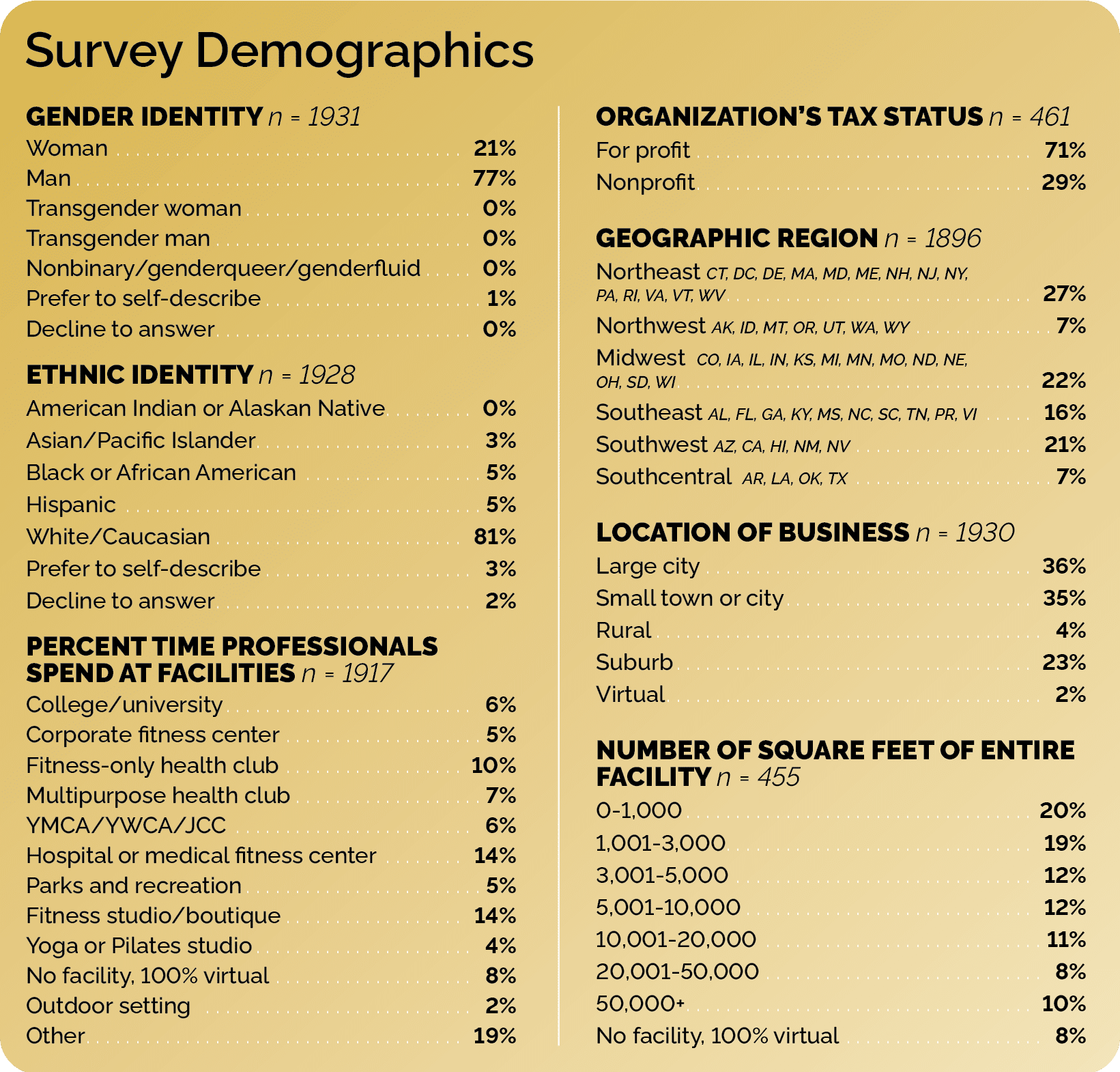
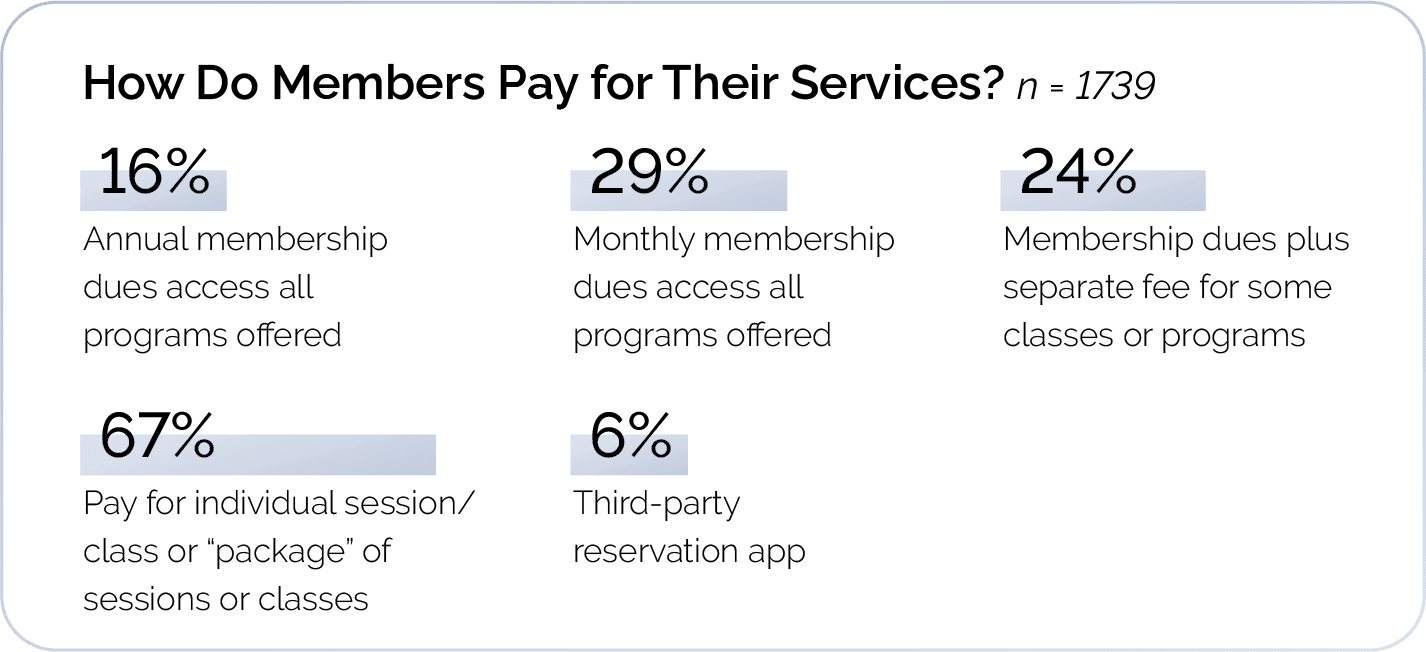
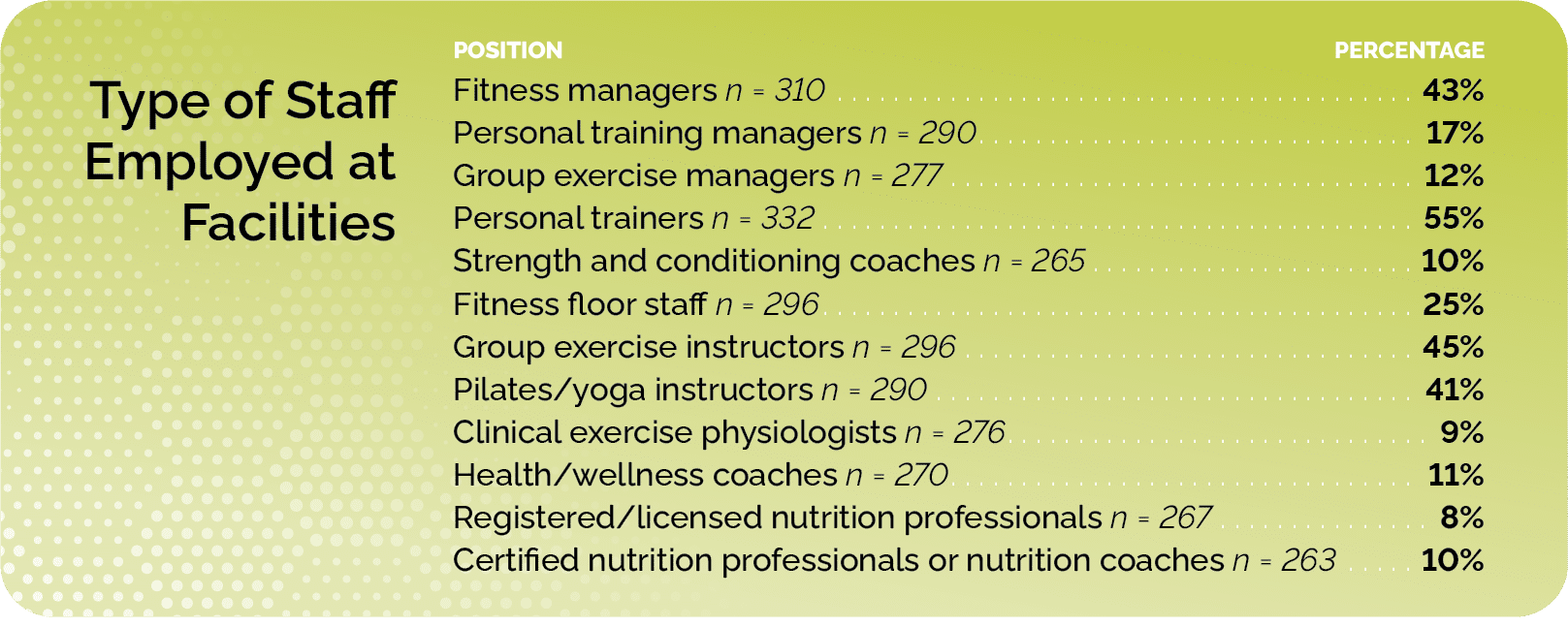
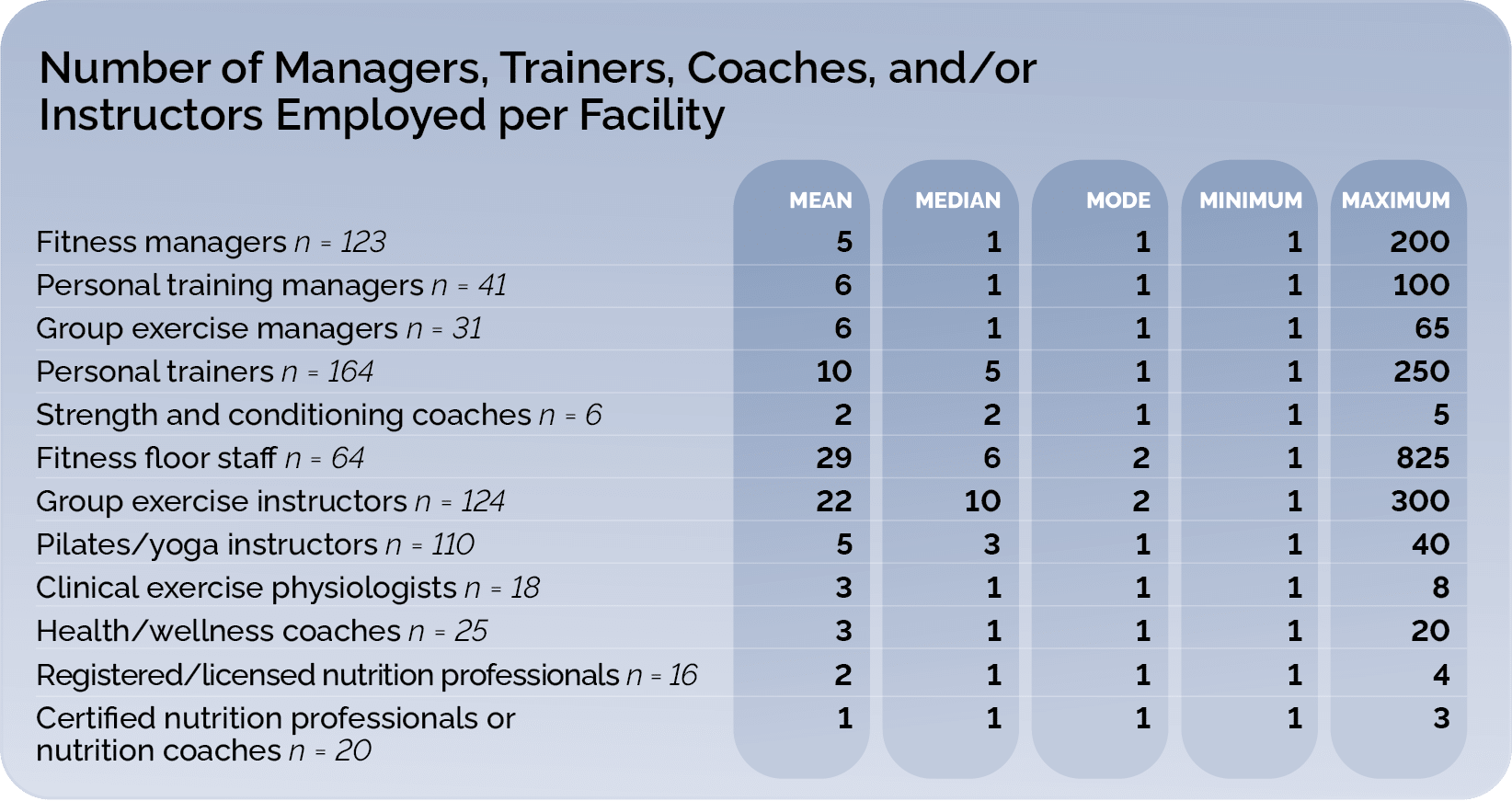
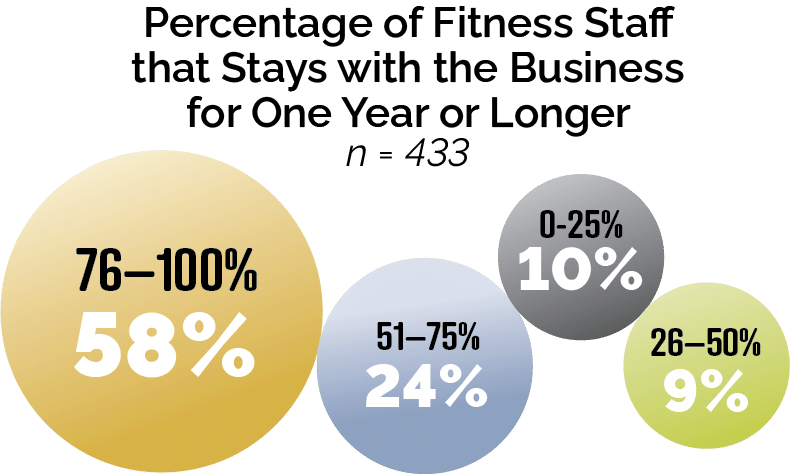

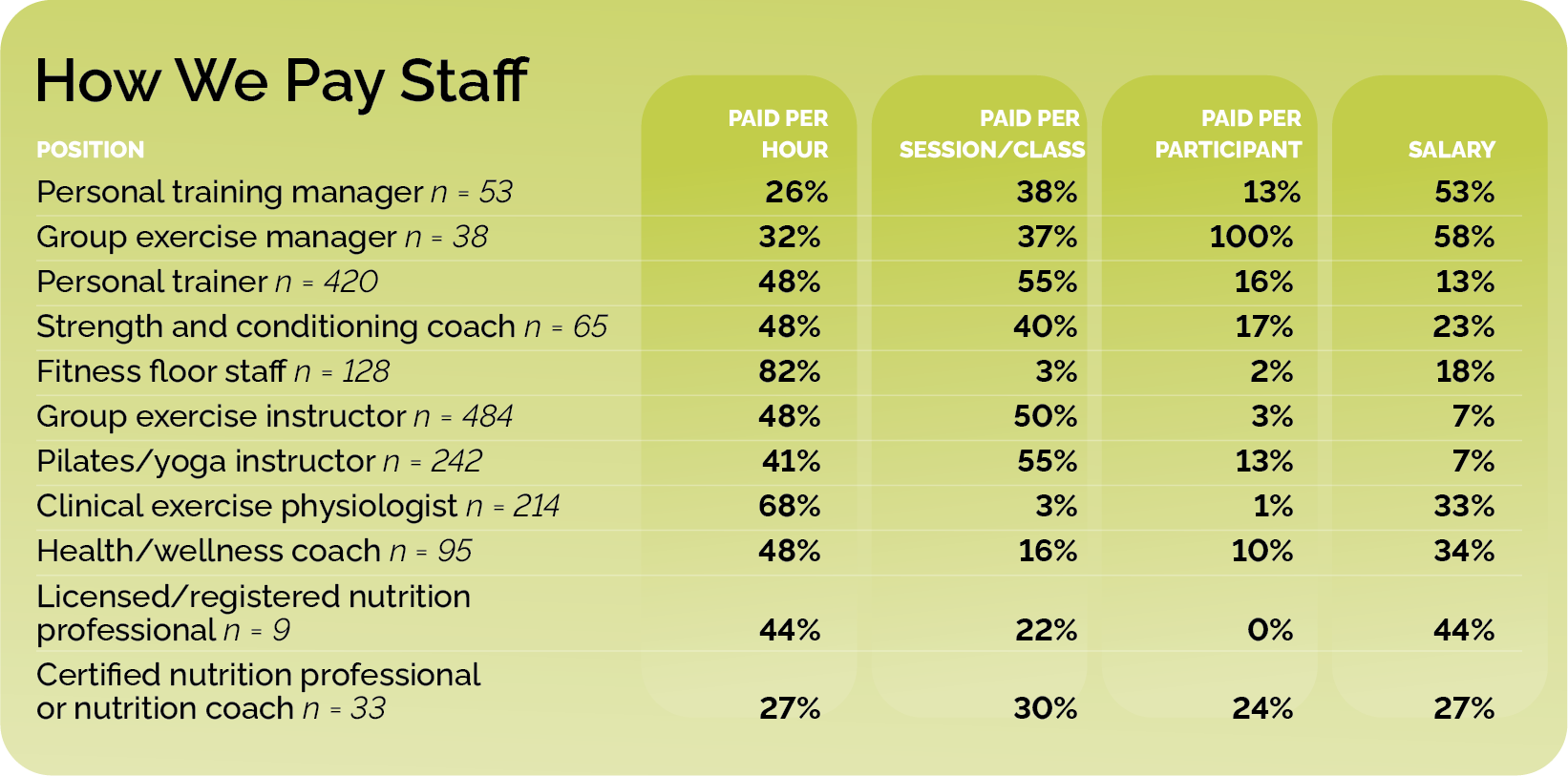
Continuing Education
Of the facilities surveyed, 52% require staff to complete an in-house training program.
Less than half of the facilities (43%) provide an education fund for staff members, with reimbursement ranging from $50 to $5,000.
While more than half of facilities pay for online education (58%), in-service-training (55%), and live event registration (50%) for their staff, only 17% pay for association membership fees.
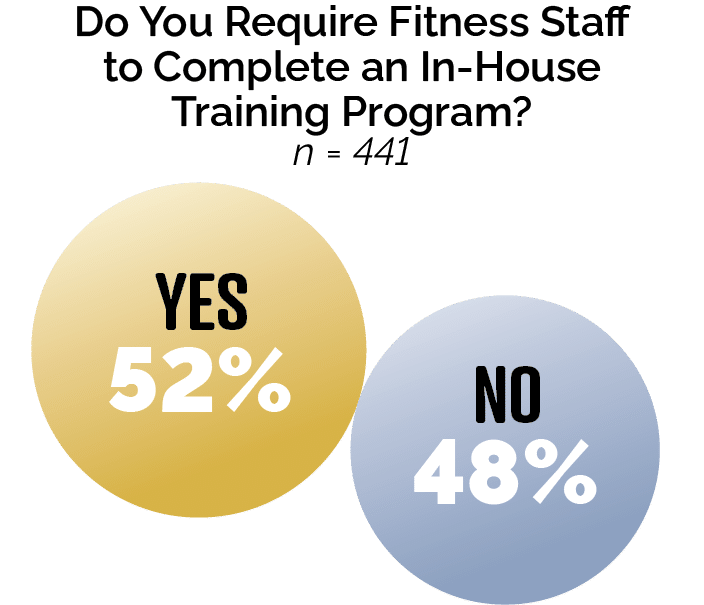
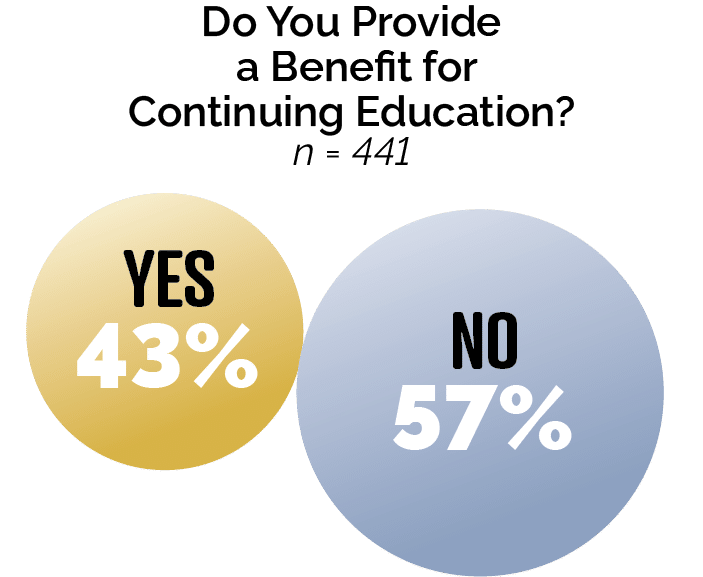
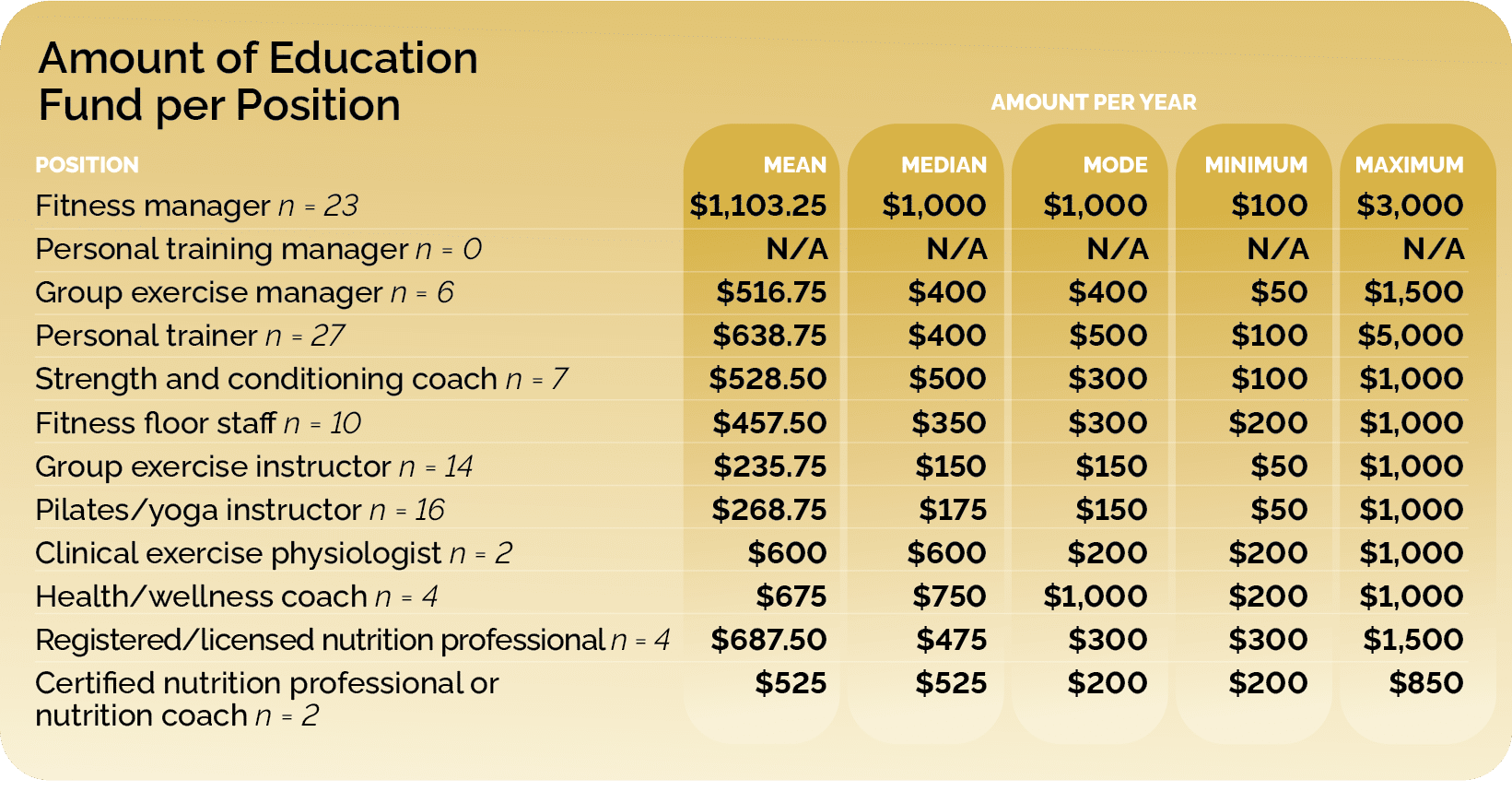
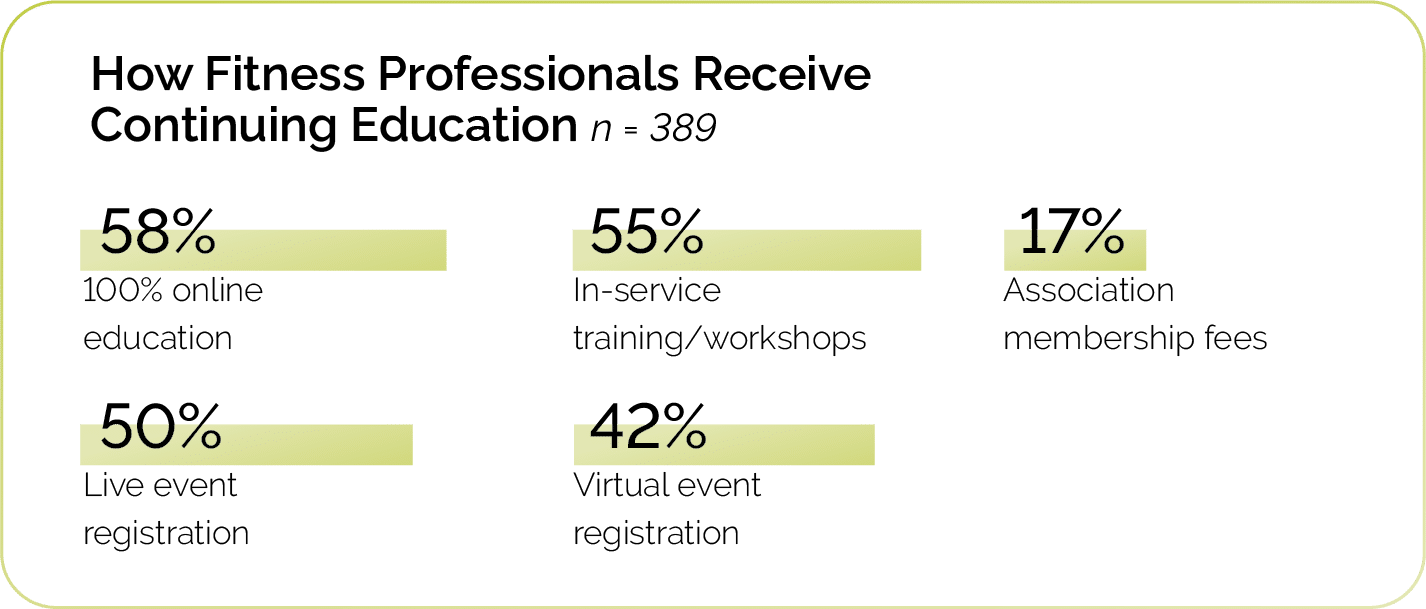
Benefits and Discounts
Full-time employees are more likely than part-timers and independent contractors to qualify for benefits and discounts.
The benefits full-time employees are most likely to receive are paid vacation time off (86%), health insurance (85%), and paid sick time off (77%).
The top three benefits for part-time employees are free or discounted club membership (71%); discounts on products, apparel, equipment or certifications (48%); and paid sick time off (35%).
Independent contractors receive very few benefits. However, over half the facilities offer free or discounted club memberships (71%) and commissions or incentives (50%).
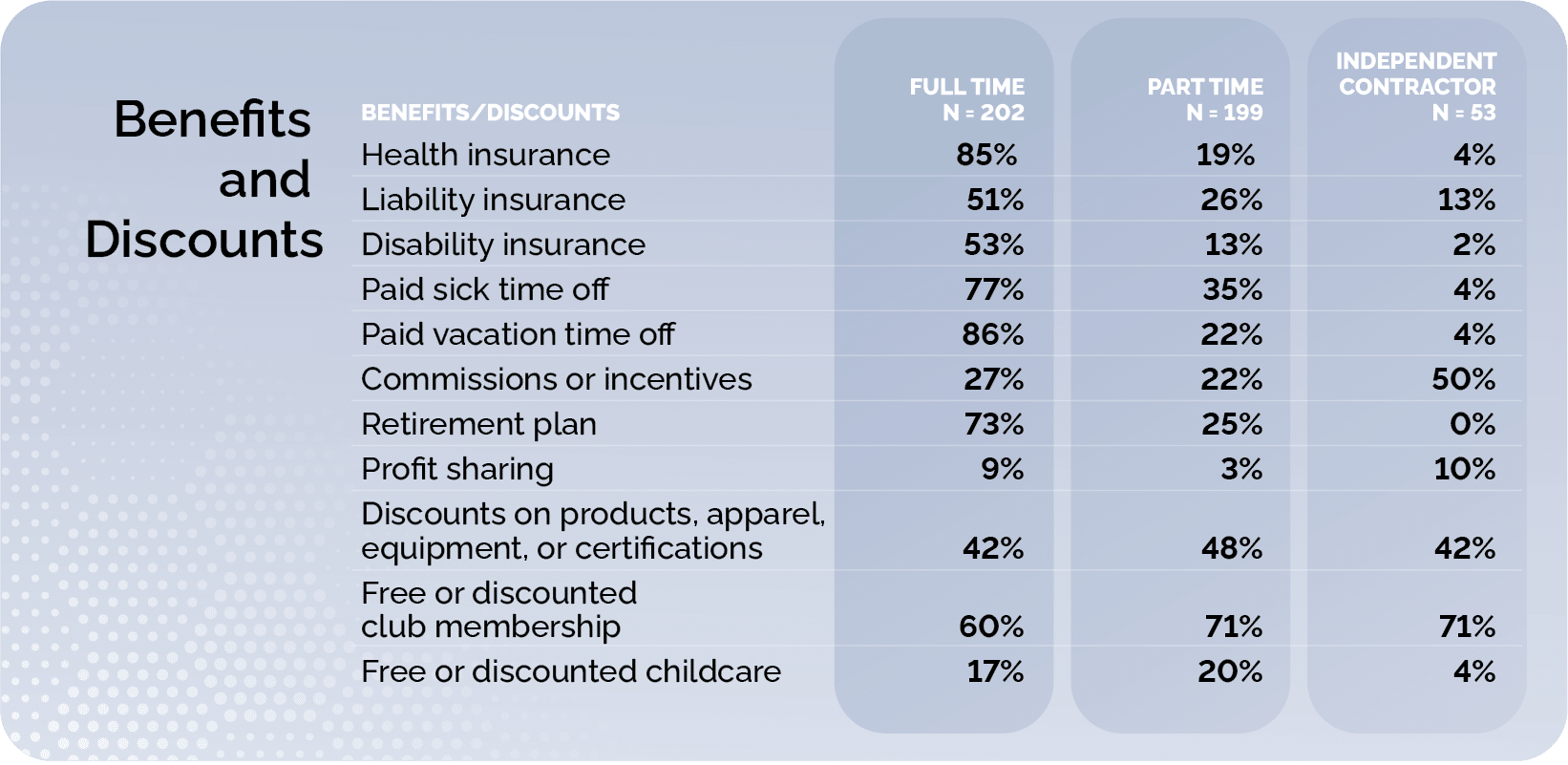
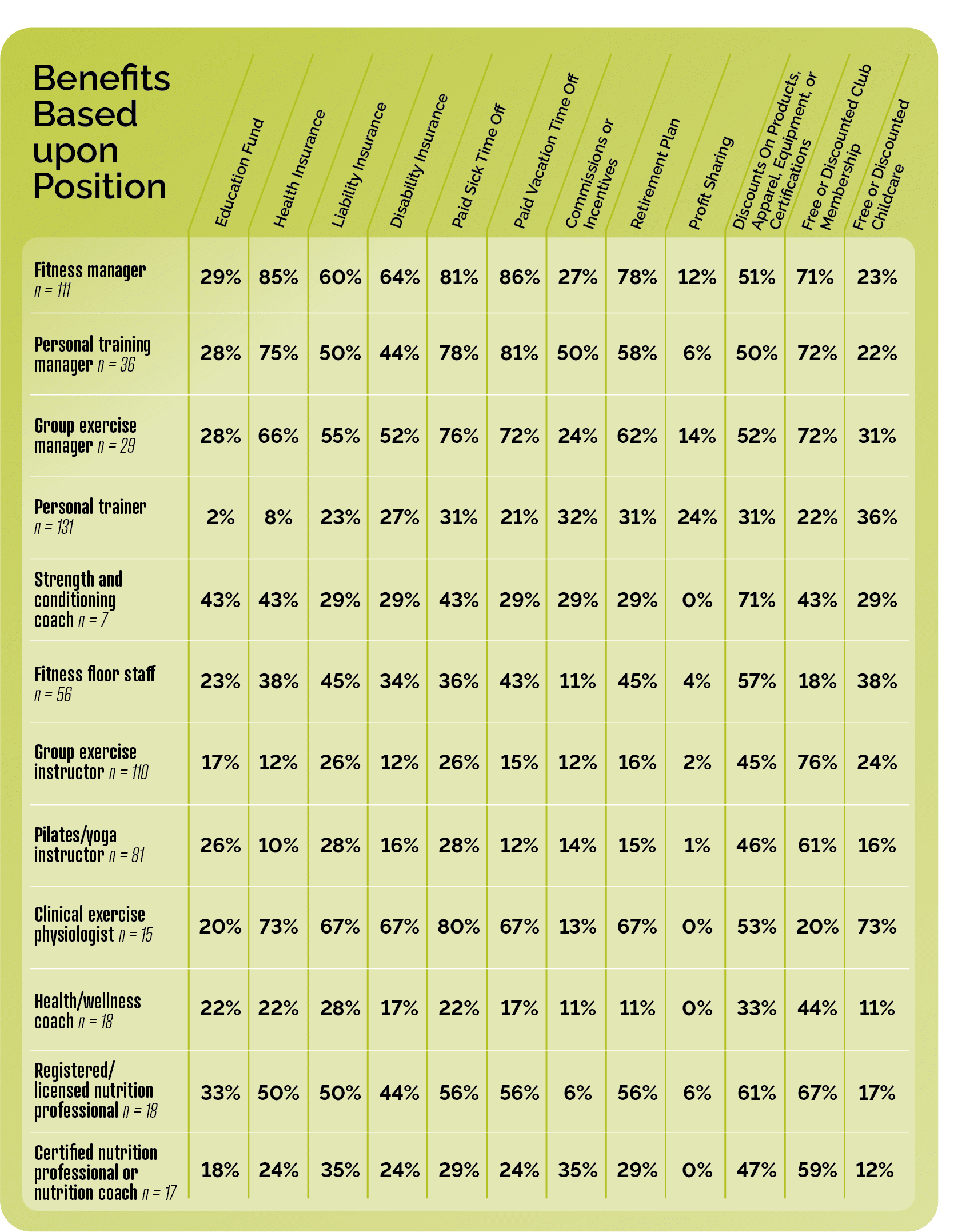
Entrepreneur/Solopreneur/Owners/Directors
This category encompasses those fitness professionals who self-identified as entrepreneur/solopreneur, health and fitness facility owners, studio owners, clinical medical fitness directors, general managers, fitness or program directors, personal training directors, and/or group exercise directors. Forty percent of this category are independent contractors, and 60% are employees, with 77% working full time.
This position reported working an average of 36 hours per week, with a range of 1-80 hours. It also reported an average salary of $61,701 with a low of $1,000 to a high of $230,000 per year.
Fitness Managers
Fitness managers oversee both group exercise instructors and personal trainers; hire and supervise staff; manage equipment; schedule or oversees scheduling of classes, lectures/clinics, training; and prepare budgets.
Most fitness managers are employees (95%), and 91% of all fitness managers work full time.
In addition to management responsibilities, 89% of fitness managers train clients and/or teach classes, 39% of which receive extra compensation.
Fitness managers average more hours per week when they are salaried (39) than when they are paid an hourly wage (29).
Fitness managers are paid a higher hourly wage as an independent contractor ($57) than as an employee ($30).
Annual salary for this position has increased to $56,744 from $43,317 in 2015, outpacing the inflation adjustment of $55,261.
Benefits that fitness managers are most likely to receive are sick time off, vacation time off, and health insurance.
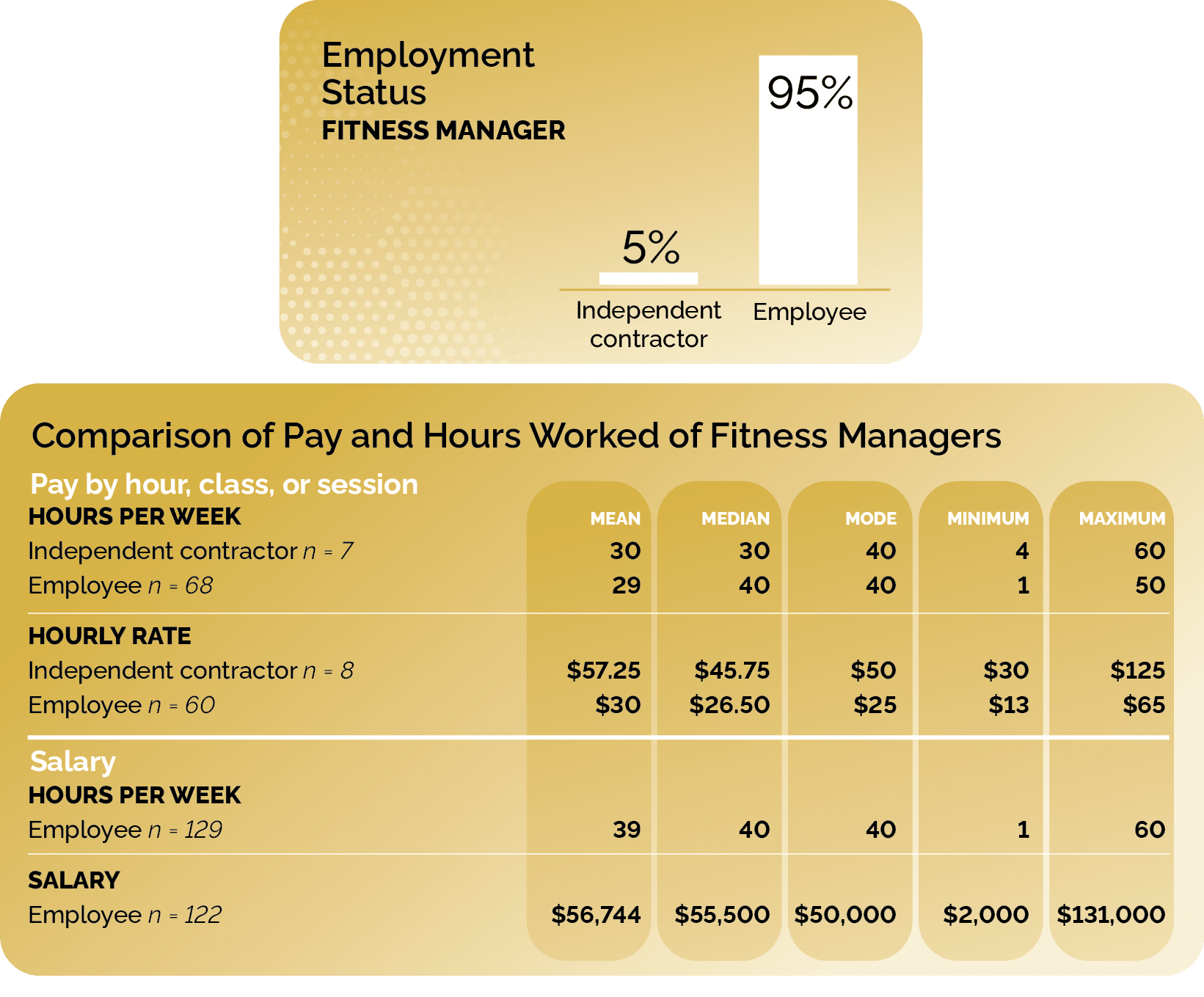
Personal Training Managers
Personal training managers hire, supervise, and schedule trainers; plan department services; and prepare budgets. They may also personal train.
Personal training managers tend to be employees of a facility (85%).
In addition to management responsibilities, 96% of personal training managers train clients, 71% of which receive extra compensation.
More than half of personal training managers are paid a salary (53%). In the past seven years, the annual salary has risen significantly, from $43,051 to $51,192; however, this increase has not kept up with inflation. Adjusted for inflation, the 2015 salary would be $54,921 today.
Benefits that personal training managers are most likely to receive are sick time off, vacation time off, and health insurance.
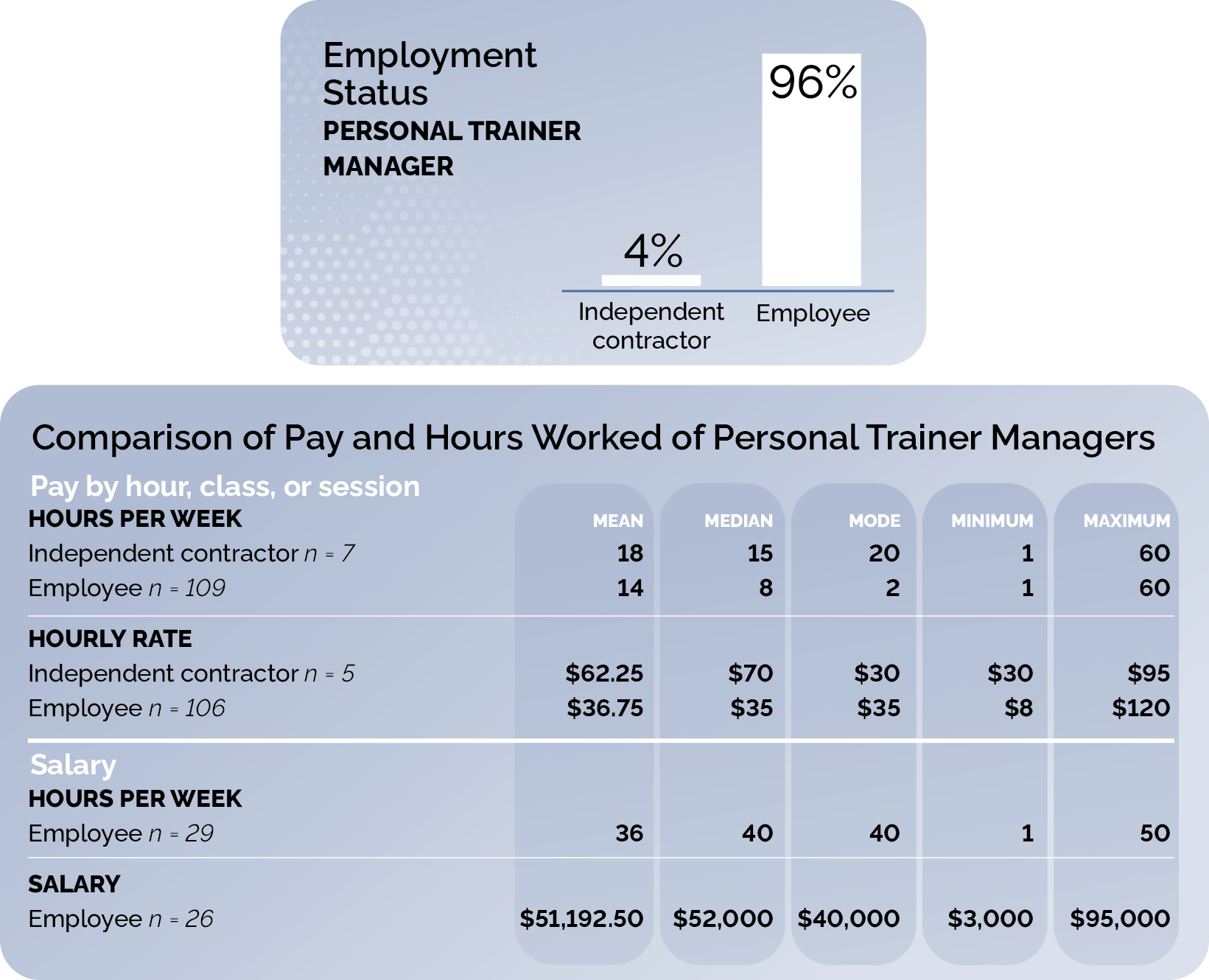
Group Exercise Managers
Group exercise managers hire, train, and supervise group exercise instructors; schedule classes and instructors; follow budgets; and may teach classes.
The majority of group exercise managers are employees (89%).
In addition to management responsibilities, 100% of group exercise managers teach classes, 63% of which receive extra compensation.
When comparing the number of hours worked in this position, employees at an hourly wage work the least number of hours (24), whereas those receiving a salary work the greatest number of hours (36), with independent contractors in between the two (30).
The annual salary of $47,341 has increased almost $10,000 from the 2015 annual salary rate of $37,871. This increase is slightly below the inflation-adjusted rate of $48,313.

Personal Trainer
Personal trainers provide one-on-one training, semi-private training, and small-group training (3-10 clients); assess programming; create original programming; monitor, adjust, and record progress; enroll new clients; and collect fees.
Fifty-five percent of facilities employ personal trainers.
The overwhelming majority of personal trainers (97%) train clients in person, at an average of two facilities.
Over half of personal trainers (53%) train one-third of their clientele (34%) remotely/virtually.
Though independent contractors and employees work approximately the same number of hours per week (18 and 19, respectively), independent contractors are paid more per hour, class, or session ($64) than employees ($35).
When compared to 2015, personal trainers are working approximately the same number of hours, but the hourly wage has increased by $4.50 for employees ($35.25). But once again, this increase has not kept up with inflation ($38).
Session rates for independent contractors are higher than for those personal trainers who are employees. In general, session rates have only slightly increased since 2015.
Management reports that 35% of personal trainers earn a percentage of client fees, with 55% of the fee going to the trainer. Independent contractors report paying the facility an average of 28% of their client fees.
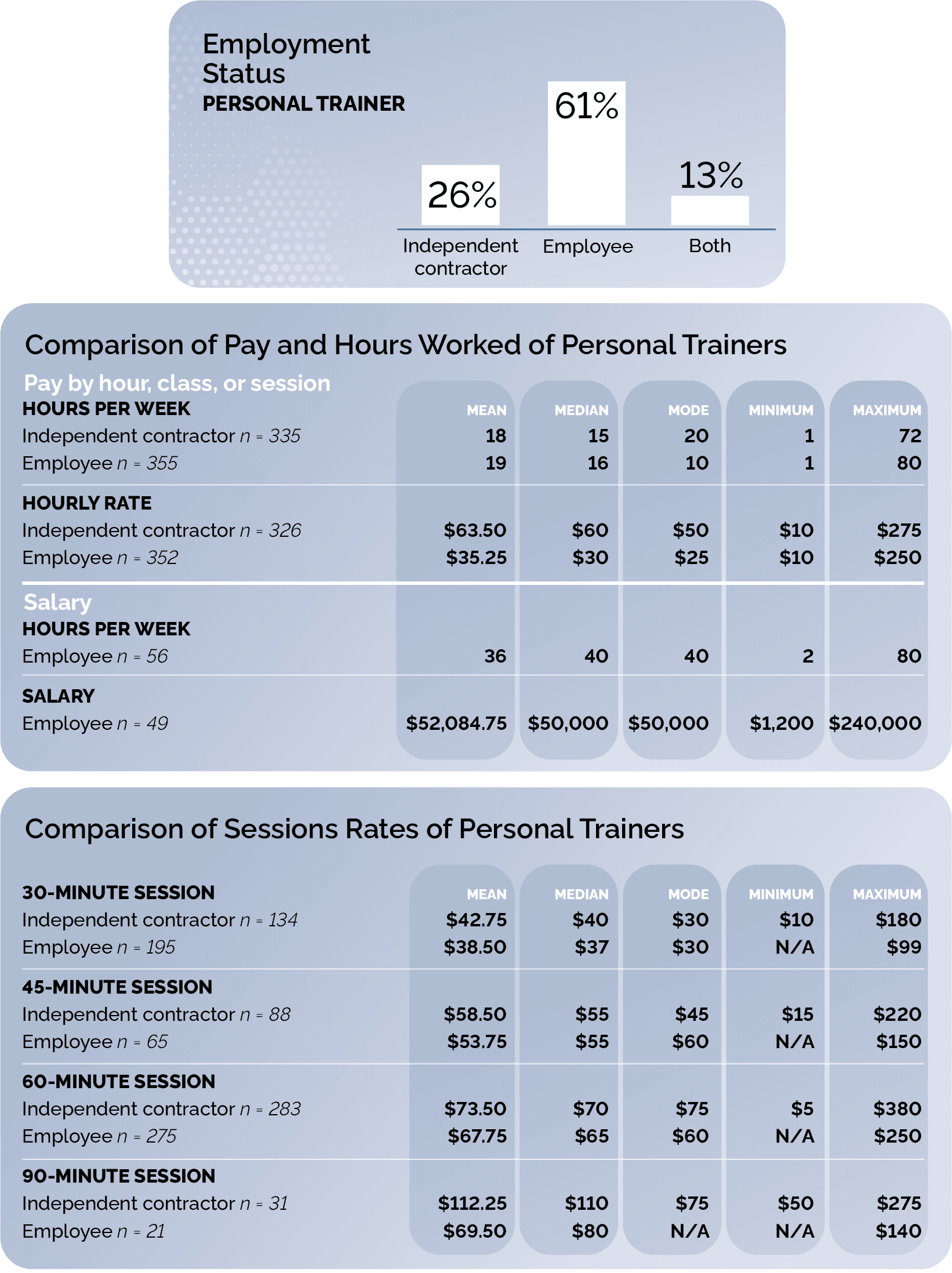
Strength and Conditioning Coach
Strength and conditioning coaches use exercise design to improve the performance of athletes or athletic teams.
Ten percent of facilities employ an average of two strength and conditioning coaches.
While more strength and conditioning coaches are hourly employees or independent contractors, those that are salaried work over double the number of hours per week (14 hours vs. 32 hours).
Strength and conditioning coaches typically train their clients in person (96%) at an average of two facilities. A little more than one-third of coaches (38%) train their clients remotely/virtually (36%).
Management reports that 31% of strength and conditioning coaches earn a percentage of client fees, with an average of 27% of the fee going to the trainer. However, strength and conditioning coaches who are employees report that on average, 64% of client fees goes to the facility. Independent contractors report paying the facility an average of 25% of their client fees.

Fitness Floor Staff
Fitness floor staff monitor equipment, supplies, and people in the fitness center. The average number of facilities that fitness floor staff work at is three facilities.
Twenty-five percent of facilities employ fitness floor staff, down from 30% in 2015.
The hourly rate for fitness floor employees has risen from $12.25 in 2015 to $18 in 2023, which is ahead of the inflation rate of $16. This trend is also seen in an increase in salary from $27,320 in 2015 to $43,538 (inflation adjustment: $34,853).
More than half of fitness floor staff (57%) are eligible for discounts on products, apparel, equipment, or certifications.

Group Exercise Instructor
Group exercise instructors lead small and large group classes such as strength, HIIT, indoor cycle, choreographed, and/or pre-formatted fitness.
Eighty-eight percent of group exercise instructors teach part time. Most group exercise instructors (96%) teach class in person at an average of two facilities. However, 34% of group exercise instructors teach classes remotely/virtually, servicing 46% of their clientele.
The number of hours that a group exercise instructor teaches has increased from five hours in 2015 to seven hours for hourly employees and 14 hours for independent contractors. Salaried employees have almost doubled the number of hours worked, from 15.5 to 30 hours per week.
Salaried employees have seen a tremendous growth in pay since 2015 ($18,000 to $45,007) — but again, their number of hours worked has just about doubled.
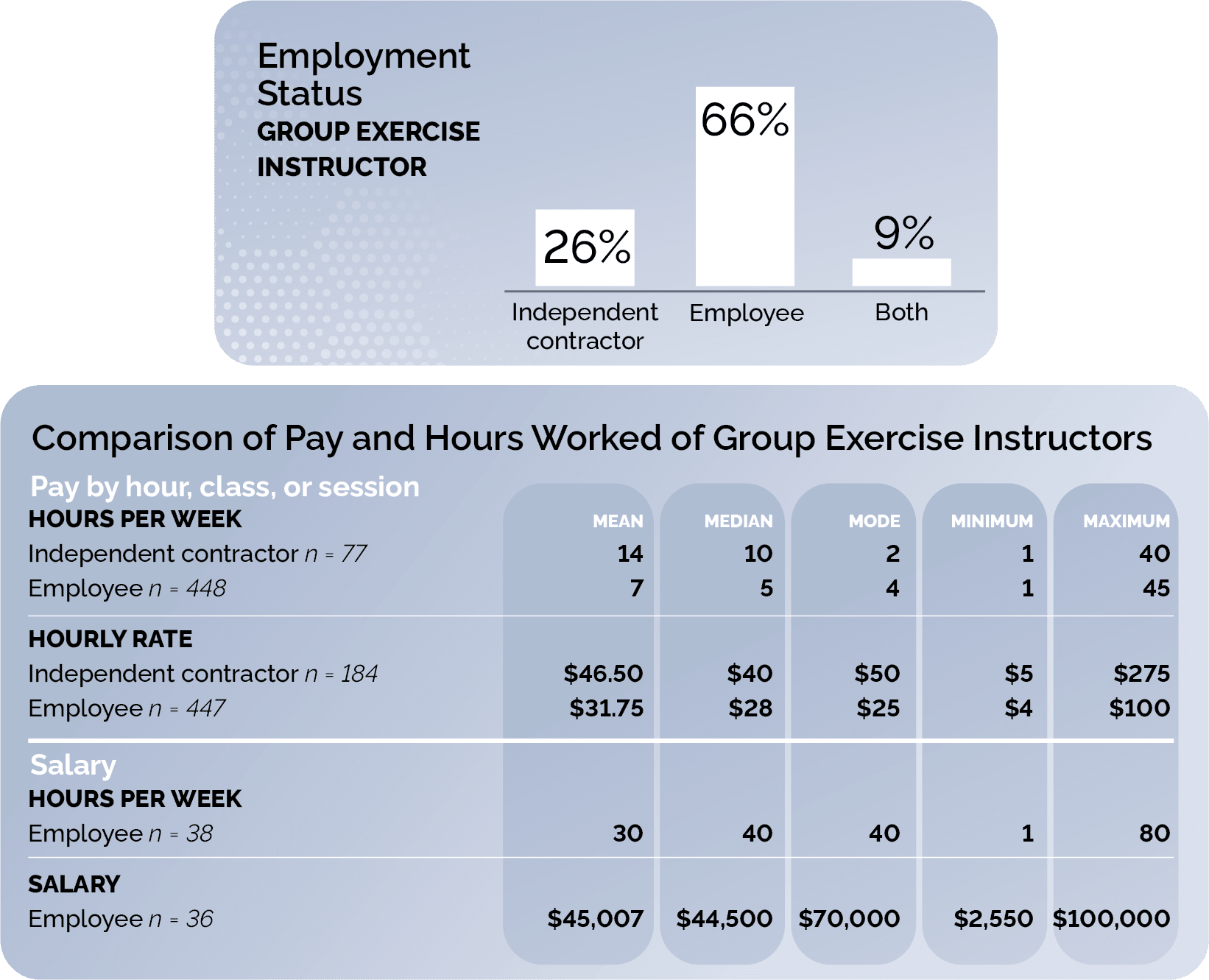
Pilates/Yoga Instructor
Pilates/yoga instructors teach classes and have specialized training in yoga or Pilates.
Forty-one percent of facilities employ an average of five Pilates/yoga instructors.
The average number of facilities that Pilates/yoga instructors teach at is two, with 95% teaching in person.
Almost 40% of instructors (39%) teach sessions remotely/virtually, coaching 36% of their clientele online.
Comparing hours spent teaching per week, independent contractors work 10 hours per week, whereas hourly employees work seven hours per week, which is an increase from five hours per week in 2015. Salaried employees have also increased the number of hours worked, from 11 hours per week in 2015 to 23 hours per week in 2023.
The hourly rate has risen from $31.25 in 2015 to $35 (employees) and $61 (independent contractors). Salaries have also risen since 2015, from $27,817 to $46,964.
There are only slight differences between session rates for independent contractors and employees.
Management reports that 18% of Pilates/yoga instructors earn a percentage of client fees, with an average of 55% of the fee going to the instructor, which is slightly different than the instructor reported average of 60%. Independent contractors report paying the facility an average of 31% of their client fees.
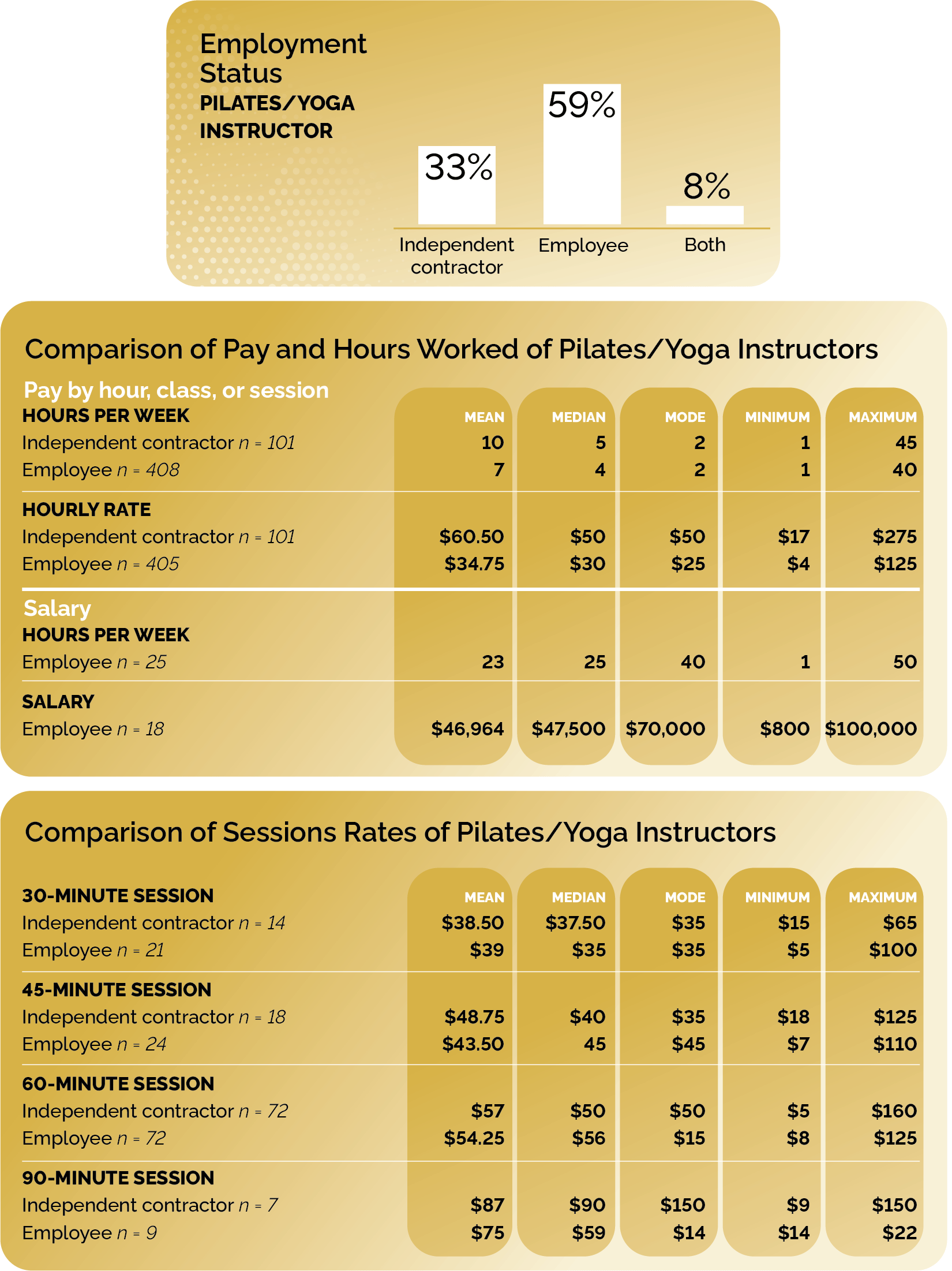
Clinical Exercise Physiologist
Clinical exercise physiologists use prescribed exercise and basic health behavior interventions, as well as promote physical activity for individuals with known disease.
Nine percent of facilities employ an average of three clinical exercise physiologists.
Only 20% of clinical exercise physiologists train remotely/virtually but assist 36% of their clientele online.
In-person training is conducted by 83% of clinical exercise physiologists, at an average of two facilities.
Employees work more hours (hourly = 26, salaried = 39) than independent contractors (14). However, independent contractors earn more per hour ($60) than hourly employees ($34).
Rates for 30- and 45-minute sessions are higher for independent contractors than employees ($51 and $78 vs. $37 and $69). However, the 60-minute session rate is higher for employees than independent contractors ($117 versus $85).
Management reports that 10% of clinical exercise physiologists earn a percentage of client fees, with 27% of the fee going to the employee. Employees report receiving an average of 62% of client fees. Independent contractors report paying the facility an average of 31% of their client fees.
The majority of clinical exercise physiologists are eligible for paid sick time off (80%), health insurance (73%), and free or discounted childcare (73%).
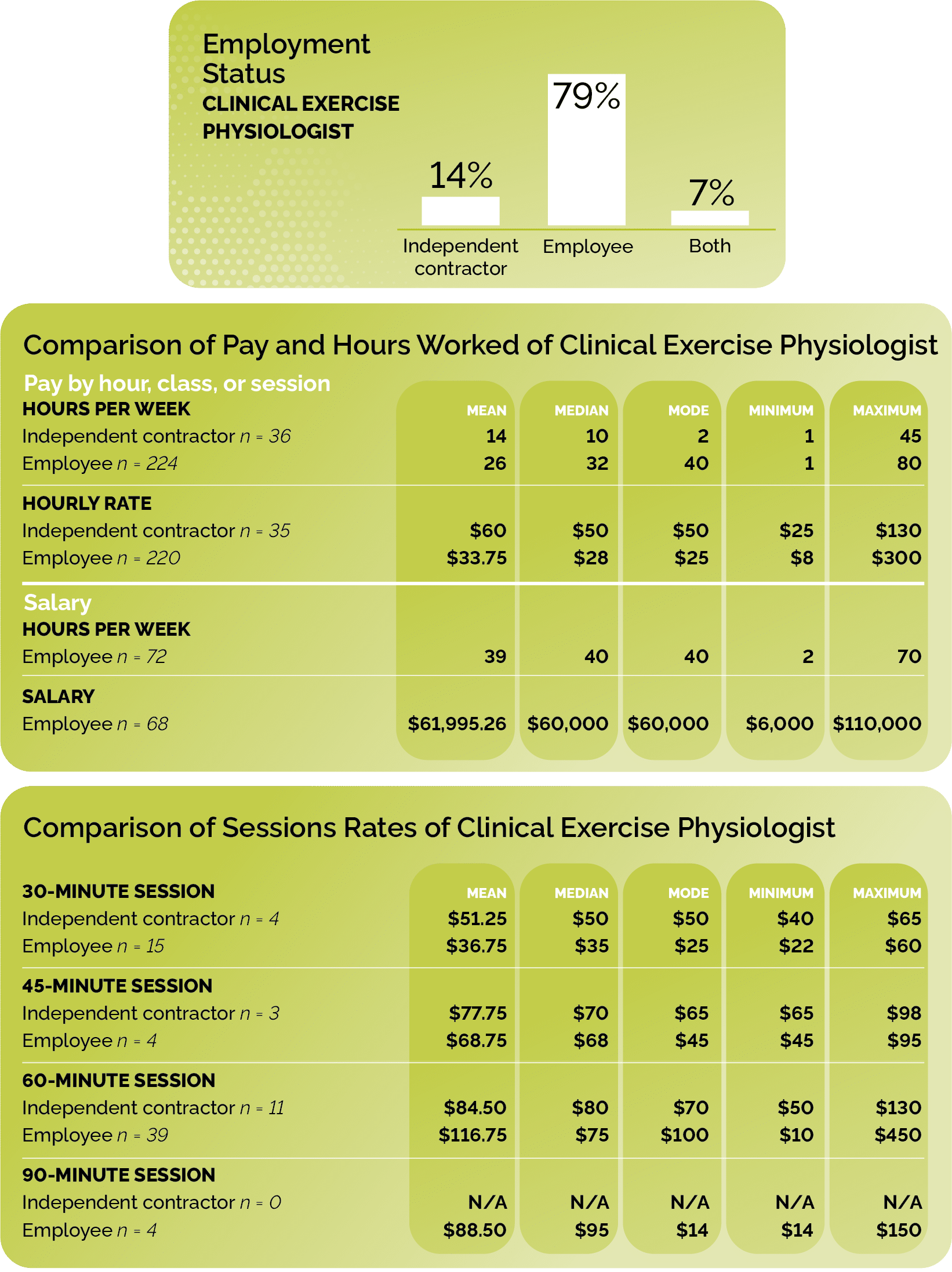
Health/Wellness Coach
Health/wellness coaches work with individuals who want to improve their health and well-being using a holistic approach. Coaches draw upon concepts from psychology, behavior change, and life coaching to help clients overcome obstacles to maintaining lifelong healthy habits.
Eleven percent of facilities employ an average of three health/wellness coaches.
Health/wellness coaches provide sessions to their clients in person (83%) at an average of two facilities.
In addition, 62% of health/wellness coaches provide remote/virtual sessions to over half of their clientele (51%).
Salaried coaches work more hours per week (33) than hourly coaches (10) and independent contractors (14).
Session rates for independent contractors are higher than employees for all sessions times, with the exception of 90-minute sessions.
Management reports that 25% of health/wellness coaches earn a percentage of client fees. Both management and health/wellness coach employees report an average of 57% of client fees going to the health/wellness coach, whereas independent contractors pay an average of 27% of client fees to the facility.
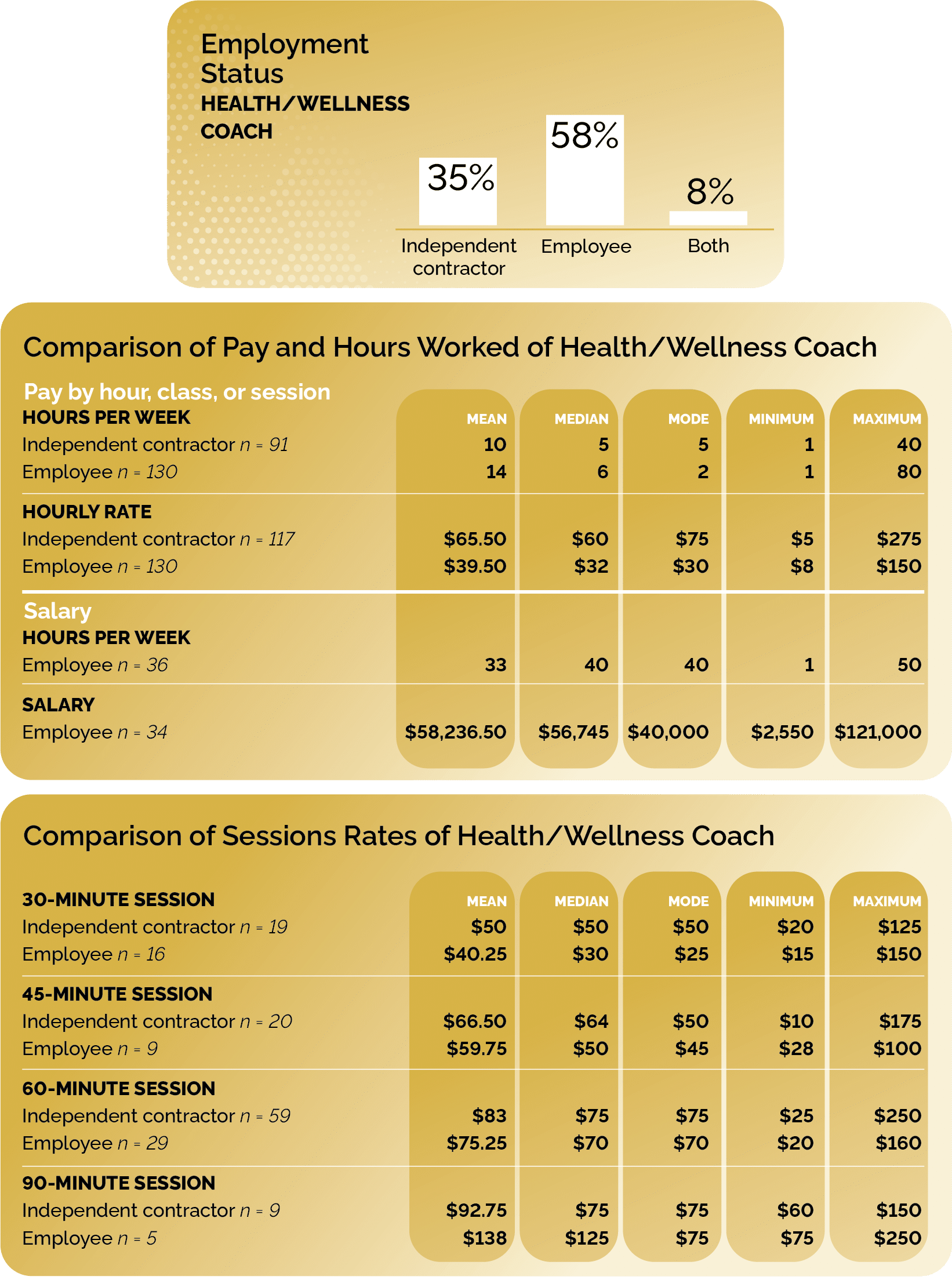
Registered/Licensed Nutrition Professional
Registered/licensed nutrition professionals are allied health pros with specialized training in diet and nutrition who can prescribe specific diets for both clients who are apparently healthy and those with diagnosed illness.
Of the registered/licensed nutrition professionals surveyed, 57% hold either a master’s or doctoral degree in nutrition or dietetics, and 43% are a licensed or registered dietician.
Registered/licensed nutrition professionals provide their services equally in person (67%) and remotely/virtually (65%). Those who counsel in-person clients do so at an average of two facilities, whereas those who counsel remotely/virtually see 61% of their clientele online.
Management reports that 19% of registered/licensed nutrition professionals earn a percentage of client fees. Fitness managers and registered/licensed nutrition professional employees differ on the percentage of client fees paid to the employee — 58% and 48%, respectively. Independent contractors report paying an average of 47% of client fees to the facility.
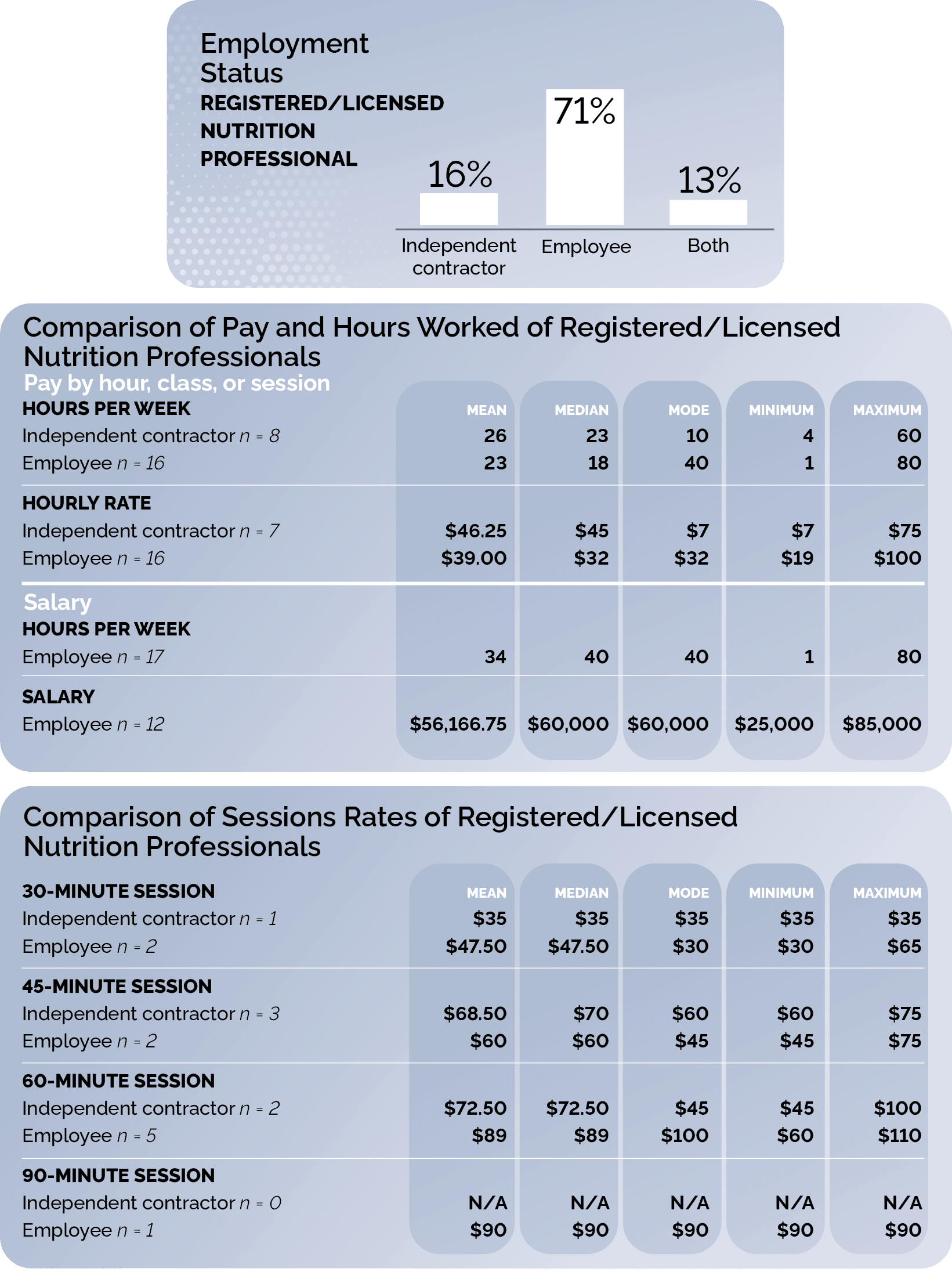
Certified Nutrition Professional or Nutrition Coach
Certified nutrition professionals/nutrition coaches are professionals who are not licensed or registered as a dietitian but who can coach clients, advise those with nutrition challenges, and support behavioral change.
Over half of nutrition coaches (56%) coach their clients (57%) remotely/virtually, whereas 70% coach their clients in person at an average of two facilities.
Both hourly employees and independent contractors work less than 20 hours per week, whereas salaried employees work an average of 34 hours per week.
Management reports that 39% of certified nutrition professionals or nutrition coaches earn a percentage of client fees. Fitness managers and employees differ slightly on the percentage of client fees paid to the employee — 66% and 61%, respectively. Independent contractors report paying an average of 27% of client fees to the facility.

Professionals Who Perform More Than One Role
Professionals who perform more than one role in the industry are most likely to be personal trainers (37%) and group exercise instructors (23%).
Data on pay, hours worked, session rates, and percentage of client fees earned were combined with those of individuals who perform a single role.

Regional Differences in Wages and Salaries
Living costs, as well as salaries and wages, vary by region. Regional comparisons of average salaries and hourly pay rates are provided for fitness professionals living in the Northeast, Northwest, Midwest, Southeast, Southwest, and Southcentral states. Caution should be taken when viewing data with low response rates.
The average salary of a fitness manager in the Southcentral states is approximately $17,000 less than the salary of a fitness manager living in the Midwest.
The hourly pay rate for a personal trainer who is an employee of a facility ranges from a low of $31 (Midwest) to a high of $43 (Southwest).
Group exercise instructors who are employees of a facility are similar across most of the regions, with less than a $1 difference among them.
There is an $11 difference in the employee hourly pay rate for Pilates/yoga instructors across the regions.
Clinical exercise physiologists make the highest hourly pay rate in the Southcentral states and the lowest hourly pay rate in the Southeast states.
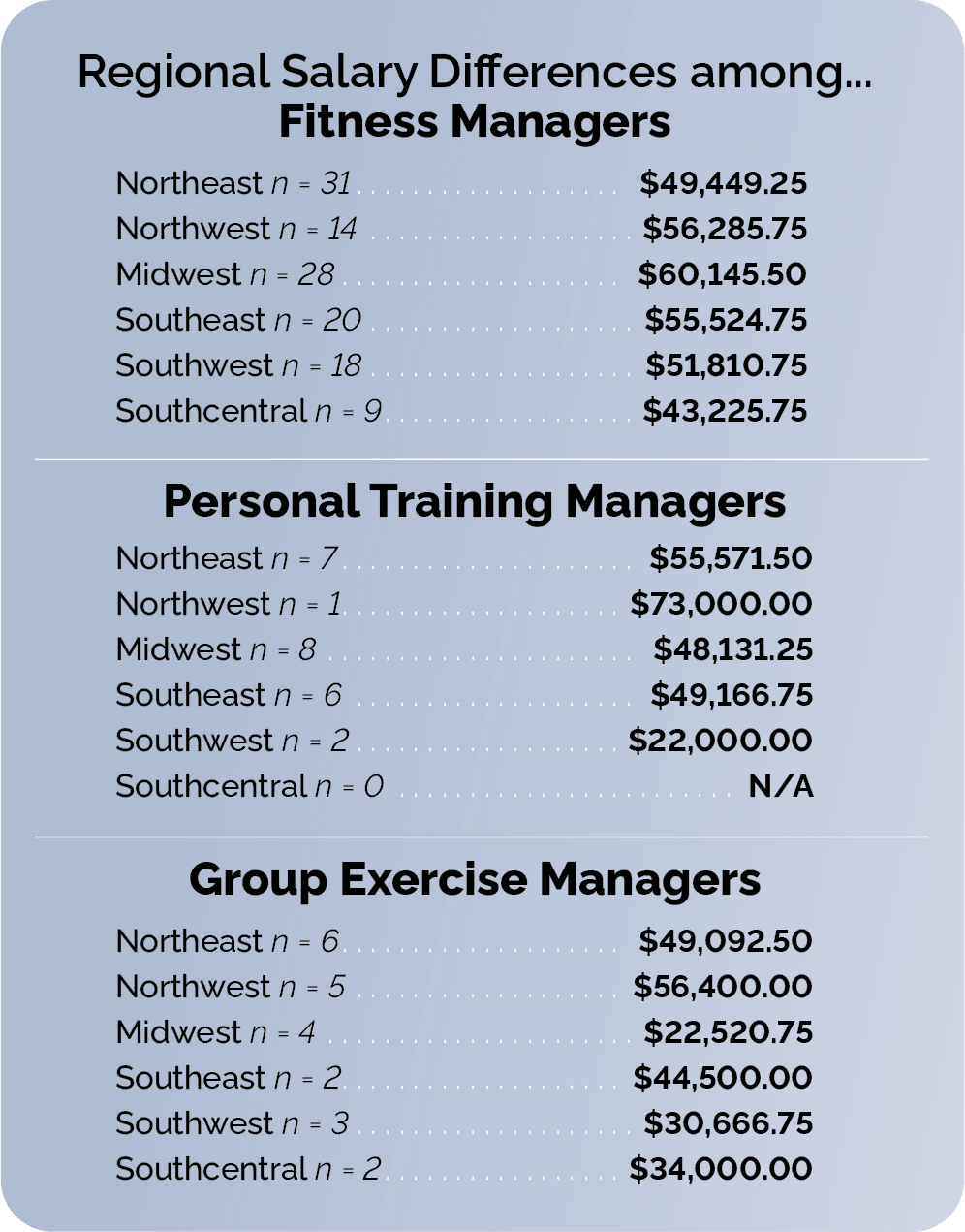

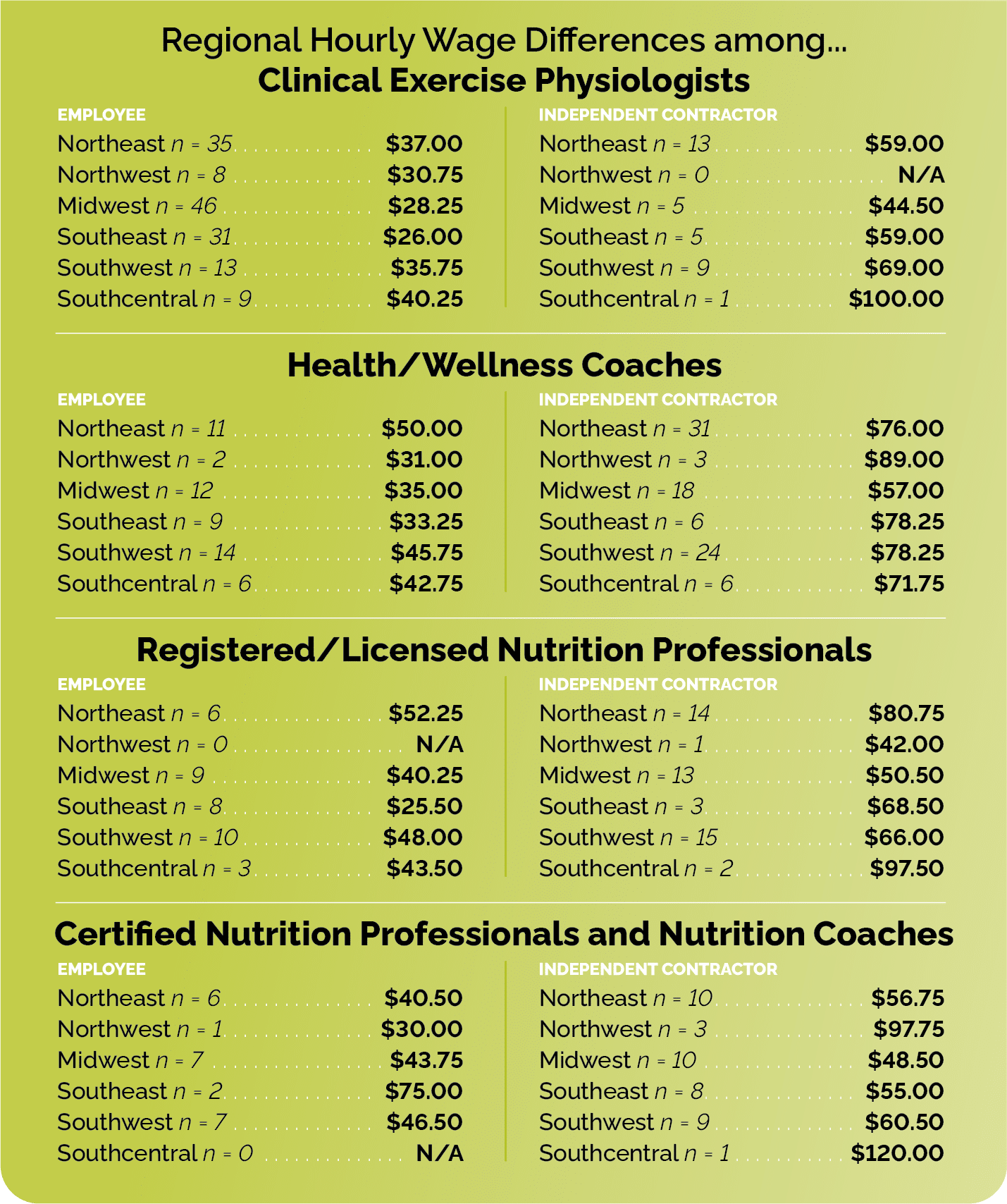
Looking Ahead
Survey respondents were asked how likely were they to see an increase in their wages in 2023-4. Results showed that management positions were much more confident in the ability to see an increase in wages for next year as compared to staff positions.

How Inflation Affects Earning
Inflation is the “overall general upward price movement of goods and services in an economy,” according to the U.S. Bureau of Labor Statistics (BLS). Among other measurements of the economy, the bureau reports the Consumer Price Index (CPI), which measures inflation as experienced by consumers in their day-to-day living expenses.
If you are interested in how inflation affects your earnings, the bureau has an online inflation calculator that uses the average CPI for a given year. You can put in a dollar amount and choose the year to compare it with at https://data.bls.gov/cgi-bin/cpicalc.pl.
What the Terms Mean
A salary is a fixed amount of money paid to an employee. A salary does not vary according to the number of hours worked.
A wage is paid to hourly workers, who may be employees or independent contractors. In the fitness industry, wages are also paid for sessions/classes. A wage goes up or down depending on the number of hours worked.
For employees, owners are required by U.S. federal and state laws to contribute to Social Security, Medicare, and other funds. For more information on each status, visit Irs.gov.
The n is the number of survey respondents who answered a question.
Of these who answered, the percent (%) shows how many answered yes.
The mean, or average, is all of the answers added together and then divided by the number of respondents. The average can be influenced by extremely high and extremely low numbers. In some cases, the extremely high and extremely low responses were eliminated to present a more accurate number.
The median is the midpoint of the data, meaning that half of the respondents answered above and half answered below.
The mode is the most frequently given response.
Methodology
In March 2023, IDEA and ACSM sent an email to their respective membership bases inviting volunteers to respond to an online survey related to compensation. The questionnaire covered various subjects related to the compensation of people currently working in a variety of health-club settings.
The questionnaire was tested prior to the beginning of the survey to ensure that it would elicit accurate responses. The survey was taken offline on March 27, 2023. As of that date, 1,943 professionals had responded to the questionnaire.
Based on the population surveyed and the number of responses received, the confidence level is 95%, with a 5% margin of error.
Decimal percentages of 0.5 and higher have been rounded up. Hours per week have been rounded to the nearest half-hour. Hourly wages have been rounded to the nearest quarter percent. When percentages do not add up to 100, it is because some respondents did not answer the question, the percentages have been rounded up, or respondents gave multiple answers.
Hiring and Promotion
In 2023, the top three criteria for hiring for most positions were years of experience, skills and abilities, and personality. Degrees earned is the main criterion for strength and conditioning coaches and registered/licensed nutrition professionals.
Skills and abilities, and years of experience were important criteria for determining pay upon hiring. Degrees earned was also a significant criterion for determining pay for strength and conditioning coaches, clinical exercise physiologists, and registered/licensed nutrition professionals.
Performance was reported as the most important criterion used to determine pay for merit raises in all positions.
Leadership and communication skills were key factors for determining promotion in all positions except nutrition coach in which revenue generation was more important than communication skills.


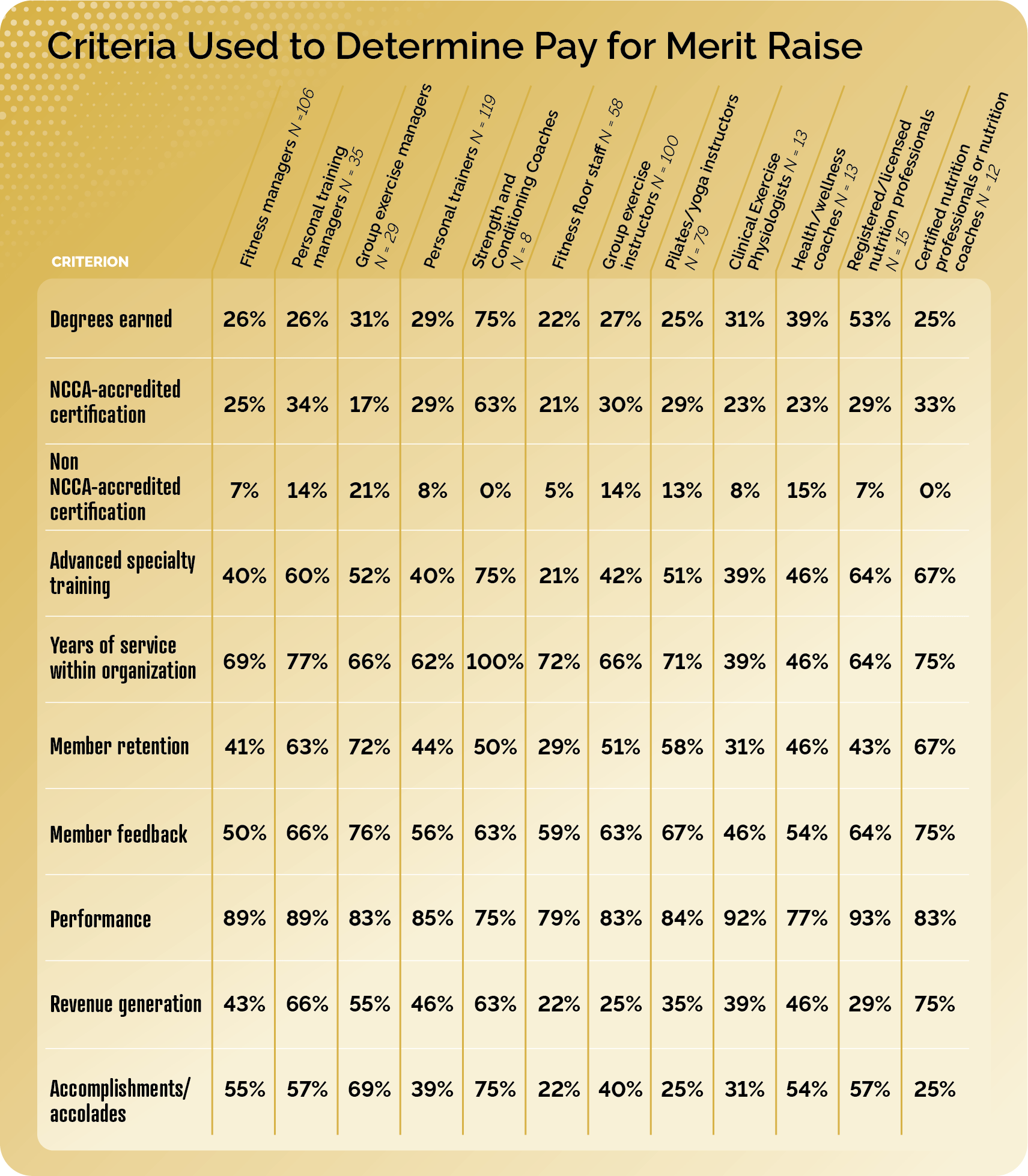

References
CPI (Consumer Price Index) Inflation Calculator. Accessed April 15, 2023. data.bls.gov/cgi-bin/cpicalc.pl.
GHFA (The Global Health & Fitness Alliance), IHRSA (International Health, Racquet & Sportsclub Association), & Deloitte. 2022. Economic Health & Societal Well-being: Quantifying the Impact of the Global Health & Fitness Sector Global Report.
Gough, C. 2022. Number of employees in the gym, health and fitness club industry in the United States from 2012 to 2021, with a forecast for 2023. Accessed April 15, 2023. Statista.com.
IRSHA: How Many Gyms Survived the Devastation that was 2020? Accessed April 15, 2023. ihrsa.org/improve-your-club/industry-news/how-many-gyms-survived-the-devastation-that-was-2020/.
Konik, R.J., Barbero, S., & MacMillan, A. 2021. Fitness Data Tracker Vol.1: Ongoing Recovery=Elongated Season. Jefferies Equity Research. April 30, 2021.
Schroeder, J. 2015. IDEA Fitness Industry Compensation Trends. IDEA Fitness Journal. October, 58-69.
US Bureau of Labor Statistics. 2022. Employment Projections Program. Accessed April 15, 2023. bls.gov/ooh/personal-care-and-service/fitness-trainers-and-instructors.htm#tab-6.
US Bureau of Labor 2023a. Labor Force Statistics from the Current Population Survey. Accessed April 15, 2023. bls.gov/cps/.
US Bureau of Labor 2023b. Employment and Average Hourly Earnings by Industry March 2023. Accessed April 15, 2023. bls.gov/charts/employment-situation/employment-and-average-hourly-earnings-by-industry-bubble.htm.
Jan Schroeder, PhD
Jan Schroeder, PhD, is a professor and past chair of the department of kinesiology at Long Beach State University. She coordinates and teaches in the fitness and integrated training undergraduate program and has written 60+ articles on exercise physiology/fitness. She is also a certified group exercise instructor who teaches weekly in the private sector. Schroeder is the recipient of the 2021 IDEA Fitness Leader of the Year Award.




